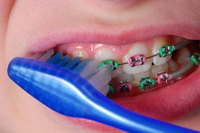About Braces
Arch Wire
This is the part of your braces which actually moves the teeth. The arch wire is attached to the brackets by small elastic ligatures or wires. Arch wires are changed throughout the treatment. Each change brings you closer to the ideal tooth position.
Brackets
Brackets are the “Braces” or small attachments that are bonded directly to the tooth surface. The brackets are the part of your braces to which the orthodontist or assistant attaches the arch wire.
Occasionally, a bracket may come loose and become an irritation to your mouth. You can remove the loose bracket and save it in an envelope to bring to the office. Please call the office if a loose bracket is irritating you or if you are in discomfort.
Elastics (Rubber Bands)
At some time during treatment, it may be necessary to wear elastics to coordinate the upper and lower teeth and perfect the bite. Once teeth begin to move in response to elastics, they move rapidly and comfortably. If elastics (rubber bands) are worn intermittently, they will continually “shock” the teeth and cause more soreness. When elastics are worn one day and left off the next, treatment slows to a standstill or stops. Sore teeth between appointments usually indicate improper wear of headgear or elastics or inadequate hygiene. Wear your elastics correctly, attaching them as you were told. Wear elastics all the time, unless otherwise directed. Take your elastics off while brushing. Change elastics as directed, usually once or twice a day.
Headgear
Often called a “night brace”. The headgear is used to correct a protrusion of the upper or lower jaw. It works by inhibiting the upper jaw from growing forward, or downward growth of the upper jaw or even by encouraging teeth to move forward, if that is the case.
Ligatures
Ligatures, also called O rings, are little rings used to attach the arch wire to the brackets. These rings come in standard gray or clear, but also come in a wide variety of colors to make braces more fun. Ligatures are changed at every appointment to maintain good attachment of the arch wire to the bracket, enabling our patients to enjoy many different color schemes throughout treatment.
Separator
A plastic or rubber donut piece which the orthodontist uses to create space between your teeth for bands used in preparation for the placement of braces.

Braces Care
 You will be shown the proper care of your braces when your
orthodontic treatment begins. Proper cleansing of your mouth is
necessary every time you eat. Teeth with braces are harder to clean, and
trap food very easily. If food is left lodged on the brackets and wires,
it can cause unsightly etching and permanent white marks on the enamel on your teeth. Your most
important job is to keep your mouth clean. If food is allowed to
collect, the symptoms of gum disease will show in your mouth. The gums
will swell and bleed and the pressure from the disease will slow down
tooth movement.
You will be shown the proper care of your braces when your
orthodontic treatment begins. Proper cleansing of your mouth is
necessary every time you eat. Teeth with braces are harder to clean, and
trap food very easily. If food is left lodged on the brackets and wires,
it can cause unsightly etching and permanent white marks on the enamel on your teeth. Your most
important job is to keep your mouth clean. If food is allowed to
collect, the symptoms of gum disease will show in your mouth. The gums
will swell and bleed and the pressure from the disease will slow down
tooth movement.
BRUSHING: You should brush your teeth 4-5 times per day.
- Brush back and forth across……between the wires and gums on the upper and lower to loosen any food particles.
- Next, brush correctly as if you had no brackets or appliances on.
- Start on the outside of the uppers with the bristles at a 45 degree angle toward the gum and scrub with a circular motion two or three teeth at a time using ten strokes, then move on.
- Next, do the same on the inner surface of the upper teeth.
- Then, go to the lower teeth and repeat steps 1 & 2.
Look in a mirror to see if you have missed any places. Your teeth, brackets and wires should be free of any food particles and plaque.
Note: If your gums bleed when brushing, do not avoid brushing, but rather continue stimulating the area with the bristles. Be sure to angle your toothbrush so that the area under your gum line is cleaned. After 3 or 4 days of proper brushing, the bleeding should stop and your gums should be healthy again.
FLOSSING: Use a special floss threader to floss with your braces on. Be sure to floss at least once per day.
FLUORIDE RINSE OR GEL: Are recommended for preventive measures. Fluoride rinses or gels are very helpful in protecting enamel by hardening the surface.
Appliance Care
Clean the retainer by brushing with toothpaste. If you are wearing a lower fixed retainer be extra careful to brush the wire and the inside of the lower teeth. Always bring your retainer to each appointment. Avoid flipping the retainer with your tongue, this can cause damage to your teeth as well as the retainer. Place the retainer in the plastic case when it is removed from your mouth. Never wrap the retainer in a paper napkin or tissue, someone may throw it away. Don’t put it in your pocket or you may break or lose it. Excessive heat will warp and ruin the retainer.
Elastics Care
If elastics (rubber bands) are worn intermittently, they will continually “shock” the teeth and cause more soreness. Sore teeth between appointments usually indicate improper wear of headgear or elastics or inadequate hygiene. Wear your elastics correctly, attaching them as instructed. Wear elastics all the time, unless otherwise directed. Take your elastics off while brushing. Change elastics as directed, usually once or twice a day.
Proper Diet
|
Avoid Sticky Foods such as: Caramels |
Avoid Hard or Tough Foods Such as: Pizza Crust
|
Cut the following foods into small pieces and chew with the back teeth: Apples |
Orthodontic Emergencies or Problems
Please feel free to contact the office if you are experiencing any discomfort or if you have any questions. Below are a few simple steps that might help if you are unable to contact us or if you need a “quick fix”.
Loose Bracket
Occasionally, a bonded bracket may come loose. You can remove the loose bracket and save it in an envelope to bring to the office or leave it where it is, if it is not causing any irritation. If a loose bracket is irritating you, please call the office.
Poking Wire
If a wire is poking your gums or cheek, there are several things you can try until you can get to the office for an appointment. First try a ball of wax on the wire that is causing the irritation. You may also try using a nail clipper or cuticle cutter to cut the extra piece of wire that is sticking out. Sometimes, a poking wire can be safely turned down so that it no longer causes discomfort. To do this you may use a pencil eraser, or some other smooth object, and tuck the offending wire back out of the way.
Wire Out of Back Brace
Please be careful to avoid hard or sticky foods that may bend the wire or cause it to come out of the back brace. If this does happen, you may use needle nose pliers or tweezers to put the wire back into the hole in the back brace. If you are unable to do this, you may clip the wire to ease the discomfort. Please call the office as soon as possible to schedule an appointment to replace the wire.
Poking Elastic (Rubber Band) Hook
Some brackets have small hooks on them for elastic wear. These hooks can occasionally become irritating to the lips or cheeks. If this happens, you may either use a pencil eraser to carefully push the hook in, or you can place a ball of wax on the hook to make the area feel smooth.
Sore Teeth
You may be experiencing some discomfort after beginning treatment or at the change of wires or adjusting of appliances. This is normal and should diminish within 24-72 hours. A few suggestions to help with the discomfort:
- Rinse with warm water, eat a soft diet, acetaminophen (Tylenol) or ibuprofen (Advil) can be taken as directed on the bottle.
- Chewing on the sore teeth may be sorer in the short term but feel better faster.
- If pain persists more than a few days, call our office.



